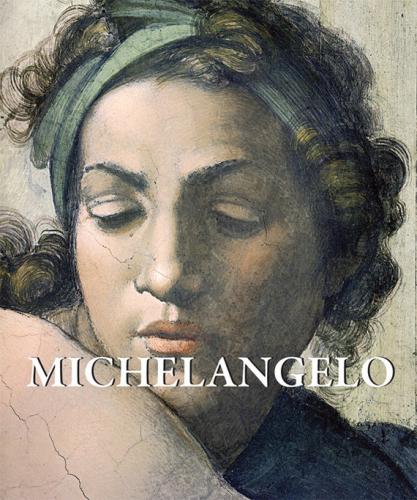The most striking thing about the works of Michelangelo’s youth, i.e. Battle of the Centaurs, the Angel Holding a Candelabra, and the The Holy Family (Tondo Doni); is the overemphasised muscles of his heroes. Instead of being round and pudgy, even the child figures have arms that look able to handle the heaviest chores and roughest fist-fights – this rebel genius yearned for a more robust humanity replete with more powerful limbs and more muscular bodies. Moving moral messages worried him little at the time: the facial features are usually morose or impassive. Like the Ancient Greeks, he was sacrificing faces for torsos.
The only period where Michelangelo excelled at representing childhood was 1494 to 1504. Chubby fulsome faces and natural life-like baby smiles are evident in the Holy Infant of the The Holy Family (Tondo Doni), the Madonna of Bruges and in one low-relief marble Madonna at the Bargello National Museum in Florence and another at Royal Academy of Arts in London. But before 1494 and after 1504, all the children look very athletic. And his recourse to compressed relief betrays a debt to Donatello.
David, 1504.
Marble, height: 434 cm.
Galleria dell’Academia, Florence.
David, 1504.
Marble, height: 434 cm.
Galleria dell’Academia, Florence.
Slave, Named Atlas, c. 1530.
Marble, height: 277 cm.
Galleria dell’Accademia, Florence.
St Matthew, 1505–1506.
Marble, height: 271 cm.
Galleria dell’Accademia, Florence.
Once back in Florence, Michelangelo did a small marble of St John the Baptist (known as Giovannino in Italy) for a poorer Medici. This statue has been linked to another found in Pisa which now resides in a Berlin museum – it is a cold stilted piece of work and its attribution to Michelangelo is highly questionable. Returning to his home town Florence, Michelangelo entered his period of greatest serenity, or perhaps it should be called impassiveness.
At the foot of the pulpit from which Savonarola bellowed out his sinister warnings, Michelangelo went on from St John the Baptist to his Sleeping Cupid and Kneeling Cupid (Victoria and Albert Museum, London), Bacchus (p. 48, 50), Death of Adonis (p. xx, Bargello National Museum) and finally his David in marble, i.e. those works that stand apart in his oeuvre by their total absence of any vehemence, passion or pathos. This abrupt plunge into introspection was the product of his exposure to Classical art at its zenith. The importance of this series of works cannot be overemphasised: they prove that, before steeping himself in tragedy, there was a quiet, congenial Michelangelo somewhat moonstruck by the beauty of Antiquity.
To understand the massive volume of work Michelangelo put out in the few years between attending Ghirlandaio’s workshop and completion of his Bacchus, Cupid, and Adonis, or to grasp his speedy, decisive, and almost miraculous emancipation of his art, we need only compare his works with those exiting the workshops of his most illustrious Tuscan peers at the time. Examination forces us to notice that, in comparison to the pure contours and fine relief of his works, theirs lack harmony, fullness, and free movement – in short, they have those ‘charming flaws’ that typify the Primitives.
On the other hand, Michelangelo demonstrates the most enviable ignorance of all the difficulties that stumped his predecessors. He hews marble as if kneading soft wax. He twists and turns human figures with playful ease, trying out the most contorted poses and always choosing the right one. Without such touching integrity and conviction throughout his works, one would think he enjoyed poking fun at obstacles. In short, if sculpture still had a long way to go before his time, Michelangelo raised it to the extreme limits of perfection and, to this day, no one can claim to have covered as much ground as he did.
Конец ознакомительного фрагмента.
Текст предоставлен ООО «ЛитРес».
Прочитайте эту книгу целиком, купив полную легальную версию на ЛитРес.
Безопасно оплатить книгу можно банковской картой Visa, MasterCard, Maestro, со счета мобильного телефона, с платежного терминала, в салоне МТС или Связной, через PayPal, WebMoney, Яндекс.Деньги, QIWI Кошелек, бонусными картами или другим удобным Вам способом.
